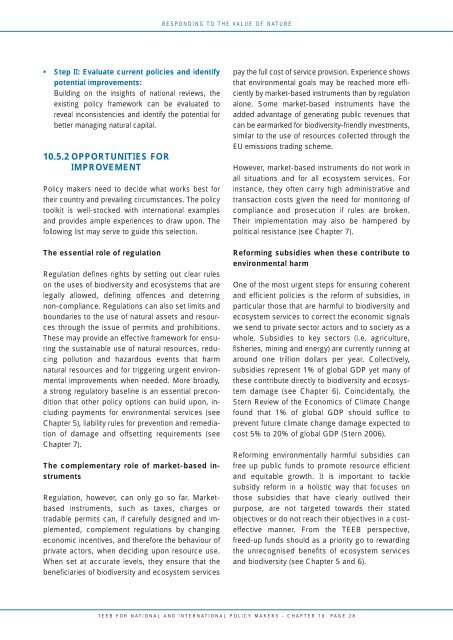Download (PDF, 6.71MB) - TEEB
Download (PDF, 6.71MB) - TEEB
Download (PDF, 6.71MB) - TEEB
You also want an ePaper? Increase the reach of your titles
YUMPU automatically turns print PDFs into web optimized ePapers that Google loves.
• Step II: Evaluate current policies and identify<br />
potential improvements:<br />
Building on the insights of national reviews, the<br />
existing policy framework can be evaluated to<br />
reveal inconsistencies and identify the potential for<br />
better managing natural capital.<br />
10.5.2 OPPORTUNITIES FOR<br />
IMPROVEMENT<br />
Policy makers need to decide what works best for<br />
their country and prevailing circumstances. The policy<br />
toolkit is well-stocked with international examples<br />
and provides ample experiences to draw upon. The<br />
following list may serve to guide this selection.<br />
The essential role of regulation<br />
Regulation defines rights by setting out clear rules<br />
on the uses of biodiversity and ecosystems that are<br />
legally allowed, defining offences and deterring<br />
non-compliance. Regulations can also set limits and<br />
boundaries to the use of natural assets and resources<br />
through the issue of permits and prohibitions.<br />
These may provide an effective framework for ensuring<br />
the sustainable use of natural resources, reducing<br />
pollution and hazardous events that harm<br />
natural resources and for triggering urgent environmental<br />
improvements when needed. More broadly,<br />
a strong regulatory baseline is an essential precondition<br />
that other policy options can build upon, including<br />
payments for environmental services (see<br />
Chapter 5), liability rules for prevention and remediation<br />
of damage and offsetting requirements (see<br />
Chapter 7).<br />
The complementary role of market-based instruments<br />
Regulation, however, can only go so far. Marketbased<br />
instruments, such as taxes, charges or<br />
tradable permits can, if carefully designed and implemented,<br />
complement regulations by changing<br />
economic incentives, and therefore the behaviour of<br />
private actors, when deciding upon resource use.<br />
When set at accurate levels, they ensure that the<br />
beneficiaries of biodiversity and ecosystem services<br />
RESPONDING TO THE VALUE OF NATURE<br />
pay the full cost of service provision. Experience shows<br />
that environmental goals may be reached more efficiently<br />
by market-based instruments than by regulation<br />
alone. Some market-based instruments have the<br />
added advantage of generating public revenues that<br />
can be earmarked for biodiversity-friendly investments,<br />
similar to the use of resources collected through the<br />
EU emissions trading scheme.<br />
However, market-based instruments do not work in<br />
all situations and for all ecosystem services. For<br />
instance, they often carry high administrative and<br />
transaction costs given the need for monitoring of<br />
compliance and prosecution if rules are broken.<br />
Their implementation may also be hampered by<br />
political resistance (see Chapter 7).<br />
Reforming subsidies when these contribute to<br />
environmental harm<br />
One of the most urgent steps for ensuring coherent<br />
and efficient policies is the reform of subsidies, in<br />
particular those that are harmful to biodiversity and<br />
ecosystem services to correct the economic signals<br />
we send to private sector actors and to society as a<br />
whole. Subsidies to key sectors (i.e. agriculture,<br />
fisheries, mining and energy) are currently running at<br />
around one trillion dollars per year. Collectively,<br />
subsidies represent 1% of global GDP yet many of<br />
these contribute directly to biodiversity and ecosystem<br />
damage (see Chapter 6). Coincidentally, the<br />
Stern Review of the Economics of Climate Change<br />
found that 1% of global GDP should suffice to<br />
prevent future climate change damage expected to<br />
cost 5% to 20% of global GDP (Stern 2006).<br />
Reforming environmentally harmful subsidies can<br />
free up public funds to promote resource efficient<br />
and equitable growth. It is important to tackle<br />
subsidy reform in a holistic way that focuses on<br />
those subsidies that have clearly outlived their<br />
purpose, are not targeted towards their stated<br />
objectives or do not reach their objectives in a costeffective<br />
manner. From the <strong>TEEB</strong> perspective,<br />
freed-up funds should as a priority go to rewarding<br />
the unrecognised benefits of ecosystem services<br />
and biodiversity (see Chapter 5 and 6).<br />
<strong>TEEB</strong> FOR NATIONAL AND INTERNATIONAL POLICY MAKERS - CHAPTER 10: PAGE 28

















